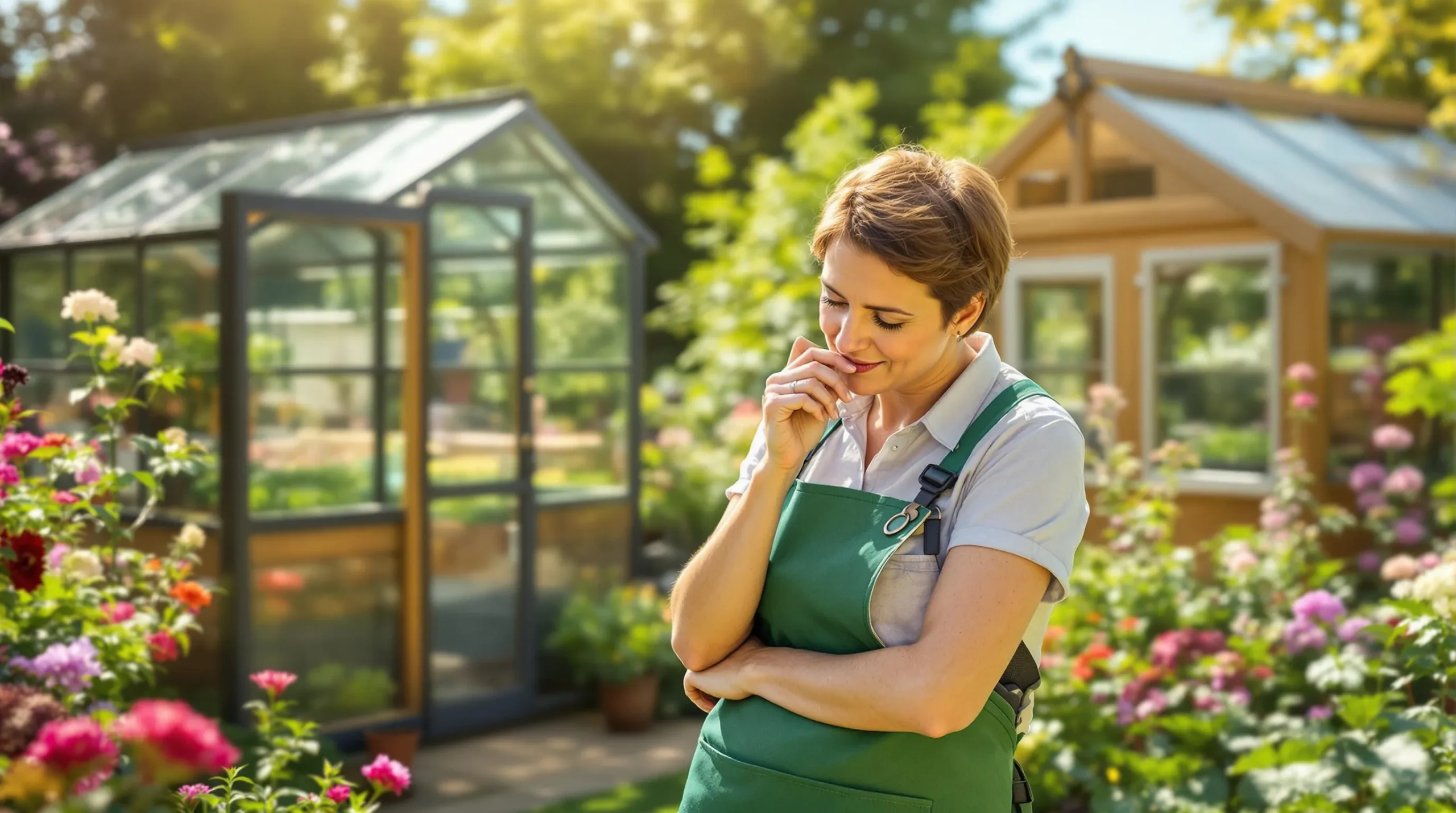
How to Choose Your First Greenhouse: A Complete Beginner’s Guide for 2025
Learn how to choose your perfect first greenhouse with our expert guide. Discover size, materials, and features to extend your growing season by 2-3 months.
Looking to create the perfect growing environment for your plants? A polycarbonate greenhouse with proper ventilation offers an ideal solution that combines durability with optimal growing conditions. With over 90% light transmission and excellent thermal insulation, these modern structures have revolutionised home gardening.
Your greenhouse’s ventilation system plays a crucial role in maintaining healthy plant growth. Polycarbonate greenhouses feature twin-wall construction that’s virtually unbreakable and provides superior insulation compared to traditional glass structures. They’re remarkably lightweight yet strong enough to withstand significant wind and rainfall, making them a practical choice for UK weather conditions.
Polycarbonate greenhouse ventilation optimises growing conditions by regulating temperature and managing airflow. Proper ventilation supports photosynthesis, prevents pest infestations, and enhances pollination.
| Temperature Effect | Benefit |
|---|---|
| Heat Reduction | Up to 8°C lower than outside temperature |
| Air Exchange | 4-6 complete air changes per hour |
| Humidity Control | Maintains 60-80% optimal range |
| Plant Protection | Prevents leaf scorching & disease |
The polycarbonate material enhances ventilation effectiveness through UV protection and heat retention properties while maintaining structural integrity in high-wind conditions.
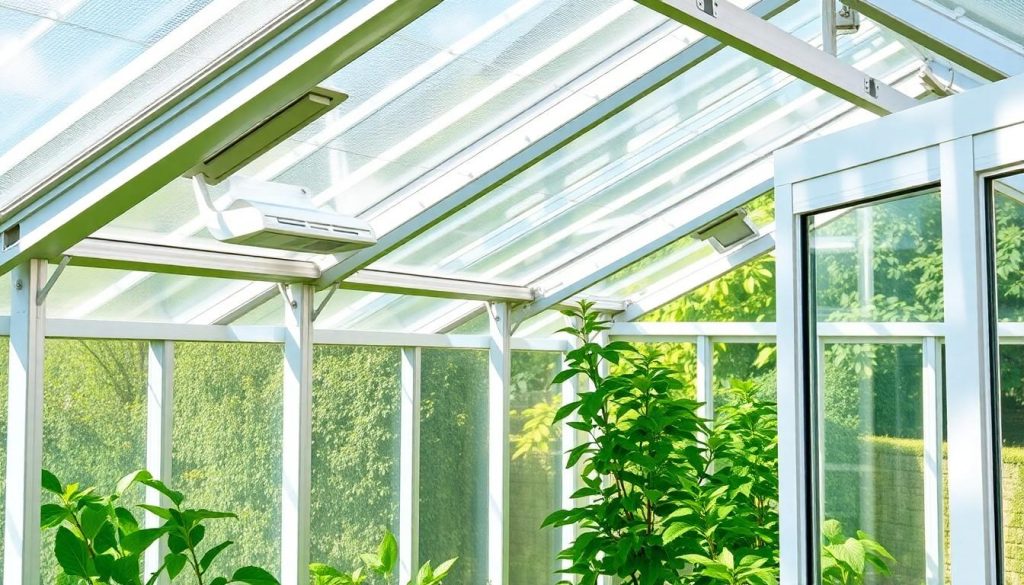
Polycarbonate greenhouse ventilation systems include passive natural airflow methods through vents and active mechanical systems using fans. The correct combination of ventilation components ensures optimal growing conditions through controlled temperature and humidity management.
Roof vents release hot air that rises to the greenhouse ceiling through thermal convection. A 10-square-foot roof vent area serves 50 square feet of floor space for effective cooling. Louvre vents integrate into polycarbonate wall panels to create cross-ventilation patterns when paired with roof openings. This dual-vent configuration allows cool air intake at ground level while expelling warm air through the top.
Side wall ventilation components include adjustable louvre panels that replace standard polycarbonate sections. The louvres enable precise airflow control through manual adjustment of the opening angle. Installing multiple side vents creates consistent air circulation patterns from ground level upward through the growing space.
| Ventilation Component | Coverage Area | Function |
|---|---|---|
| Roof Vent | 10 sq ft | Serves 50 sq ft floor area |
| Side Louvre | 1 panel width | Replaces 1 polycarbonate panel |
| Auto Opener | Single vent | Controls 1 roof/side vent |
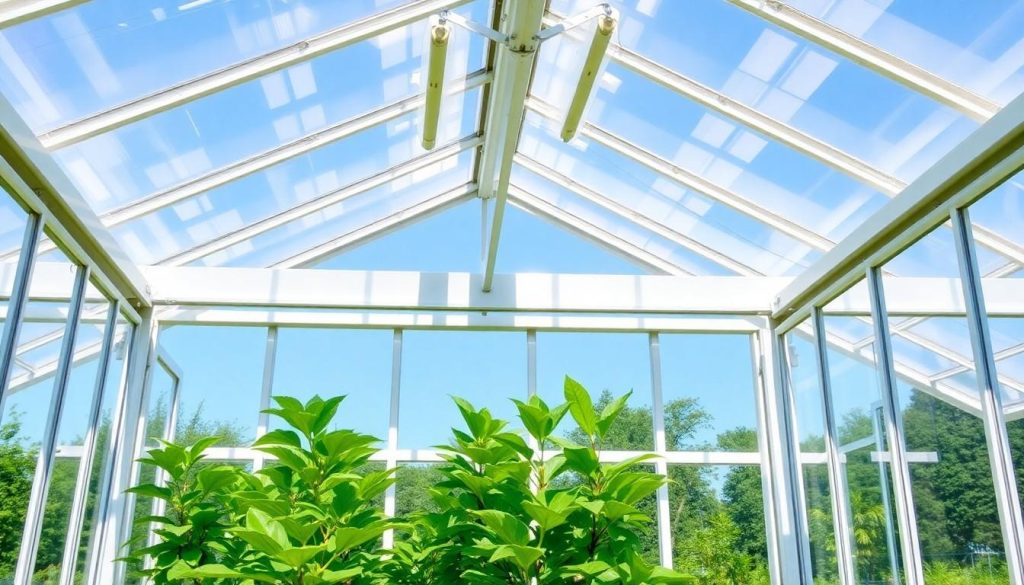
Polycarbonate greenhouse ventilation optimises growing conditions by regulating temperature and controlling humidity. The system exchanges indoor air with fresh outdoor air to keep plants healthy.
Proper ventilation regulates greenhouse temperatures through a combination of roof side vents. A 10 sq ft roof ventilation area per 50 sq ft of floor space provides adequate cooling air exchange. The ventilation system prevents temperatures from exceeding 27°C (80°F), which causes plant wilting stress.
Key temperature benefits:
The ventilation system manages moisture levels by exchanging humid indoor air with drier outdoor air. Regular damping of hard surfaces combined with proper air circulation maintains optimal humidity.
| Ventilation Metrics | Recommended Values |
|---|---|
| Roof Vent Area | 10 sq ft per 50 sq ft floor space |
| Maximum Temperature | 27°C (80°F) |
| Minimum Vent Types | Both roof side vents required |
| Air Exchange Rate | Regular cooling changes throughout day |
Installing polycarbonate greenhouse ventilation systems requires precise placement and proper assembly techniques. The effectiveness of your greenhouse ventilation depends on accurate positioning of components and following specific assembly protocols.
Optimal vent positioning creates efficient airflow patterns in your greenhouse. Place roof vents on the highest point of the structure to maximise the natural stack effect for hot air release. Side vents work best when installed:
A ventilation ratio of 10 square feet per 50 square feet of floor space maintains temperatures below 27°C. Position mechanical fans:
The installation process follows specific steps to ensure proper functionality:
When installing mechanical systems:
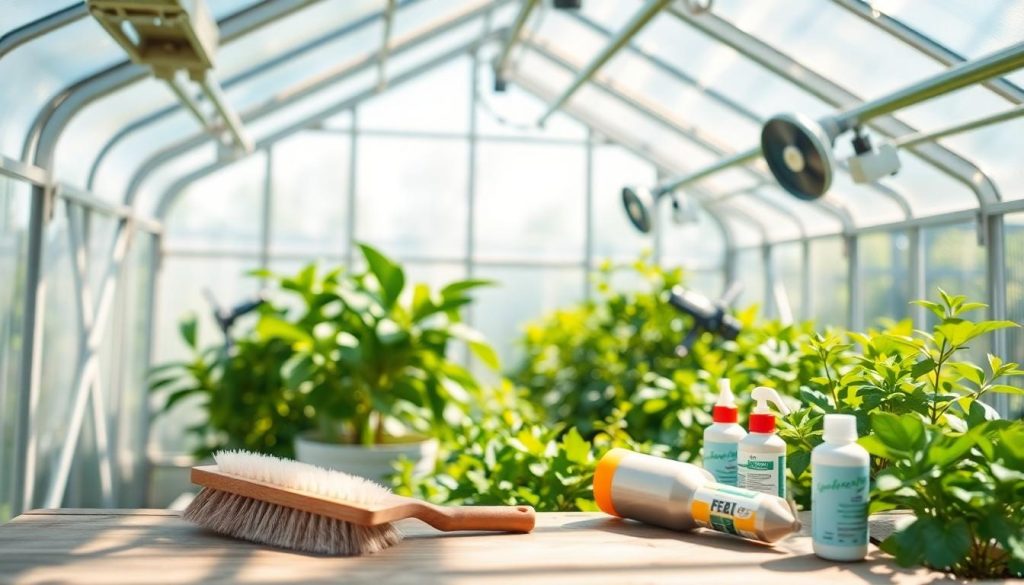
Clean ventilation fans every 3 months to maintain optimal airflow. Remove dust buildup from fan blades grills with a soft brush or compressed air. Check fan motors for unusual noises vibrations indicating potential issues. Lubricate fan bearings with machine oil according to manufacturer specifications.
Test automatic vent mechanisms monthly during growing seasons. Clean vent tracks rails to prevent debris accumulation. Apply silicone-based lubricant to moving parts hinges quarterly to ensure smooth operation. Inspect weather stripping seals around vents replace damaged sections to prevent air leaks.
| Maintenance Task | Frequency | Key Actions |
|---|---|---|
| Clean shutters | Monthly | Remove dirt debris from slats tracks |
| Test motors | Quarterly | Verify smooth opening closing operation |
| Check seals | Bi-annually | Inspect replace worn weather stripping |
| Calibrate thermostats | Seasonally | Adjust temperature settings for seasonal changes |
Inspect wiring connections every 6 months for signs of wear corrosion. Test thermostat accuracy by comparing readings with separate thermometer. Replace backup batteries in automated controllers annually. Keep electrical junction boxes sealed protected from moisture.
Create maintenance schedule calendar with specific tasks dates. Document system performance issues repairs for future reference. Store spare parts common replacement components on hand. Schedule professional inspection servicing annually before peak growing seasons.
Monitor temperature humidity levels daily using digital sensors. Track fan runtime hours to anticipate maintenance needs. Record vent operation patterns identify potential system inefficiencies. Compare energy usage patterns across seasons optimize system settings.
A well-designed polycarbonate greenhouse ventilation system is crucial for your gardening success. By implementing the right combination of passive and active ventilation components you’ll create an optimal environment for your plants to thrive.
Remember that proper maintenance and regular monitoring of your ventilation system will ensure its long-term effectiveness. The twin-wall construction of polycarbonate greenhouses coupled with strategic vent placement provides excellent climate control throughout the year.
Your investment in a quality ventilation system will pay off through healthier plants improved yields and a more enjoyable greenhouse gardening experience. With the right setup you’ll be well-equipped to maintain ideal growing conditions regardless of external weather challenges.
Polycarbonate greenhouses are perfect for UK gardens due to their exceptional durability and over 90% light transmission. Their twin-wall construction provides superior thermal insulation, protecting plants from harsh weather whilst maintaining optimal growing conditions. The material is also impact-resistant and lighter than glass, making it a practical choice for British weather.
For optimal growing conditions, install 10 square feet of roof ventilation for every 50 square feet of floor space. This ratio helps maintain temperatures below 27°C (80°F), preventing plant stress. A combination of roof vents and side louvres ensures effective cross-ventilation and proper air exchange.
Regular maintenance is essential: clean fans quarterly, test automatic vent mechanisms monthly, and inspect electrical components twice yearly. Create a maintenance calendar and document performance issues. Daily monitoring of temperature and humidity levels helps optimise system settings and identify potential problems early.
Yes, polycarbonate greenhouses can be fitted with automated ventilation systems. Temperature-controlled mechanisms automatically adjust vents based on internal conditions. These can be combined with manual controls for customised air circulation, offering convenience and precise environmental management.
Install roof vents at the highest point for heat release and side vents at opposite ends for cross-ventilation. Use automatic vent openers that respond to temperature changes, and consider adding shade screens during peak summer months. Proper ventilation helps maintain temperatures below 27°C (80°F) through natural convection.
Proper ventilation regulates temperature, controls humidity, prevents disease, and supports healthy plant growth. It exchanges stale indoor air with fresh outdoor air, reduces condensation, prevents fungal infections, and enhances pollination. The system also helps maintain consistent growing conditions throughout different seasons.

Learn how to choose your perfect first greenhouse with our expert guide. Discover size, materials, and features to extend your growing season by 2-3 months.
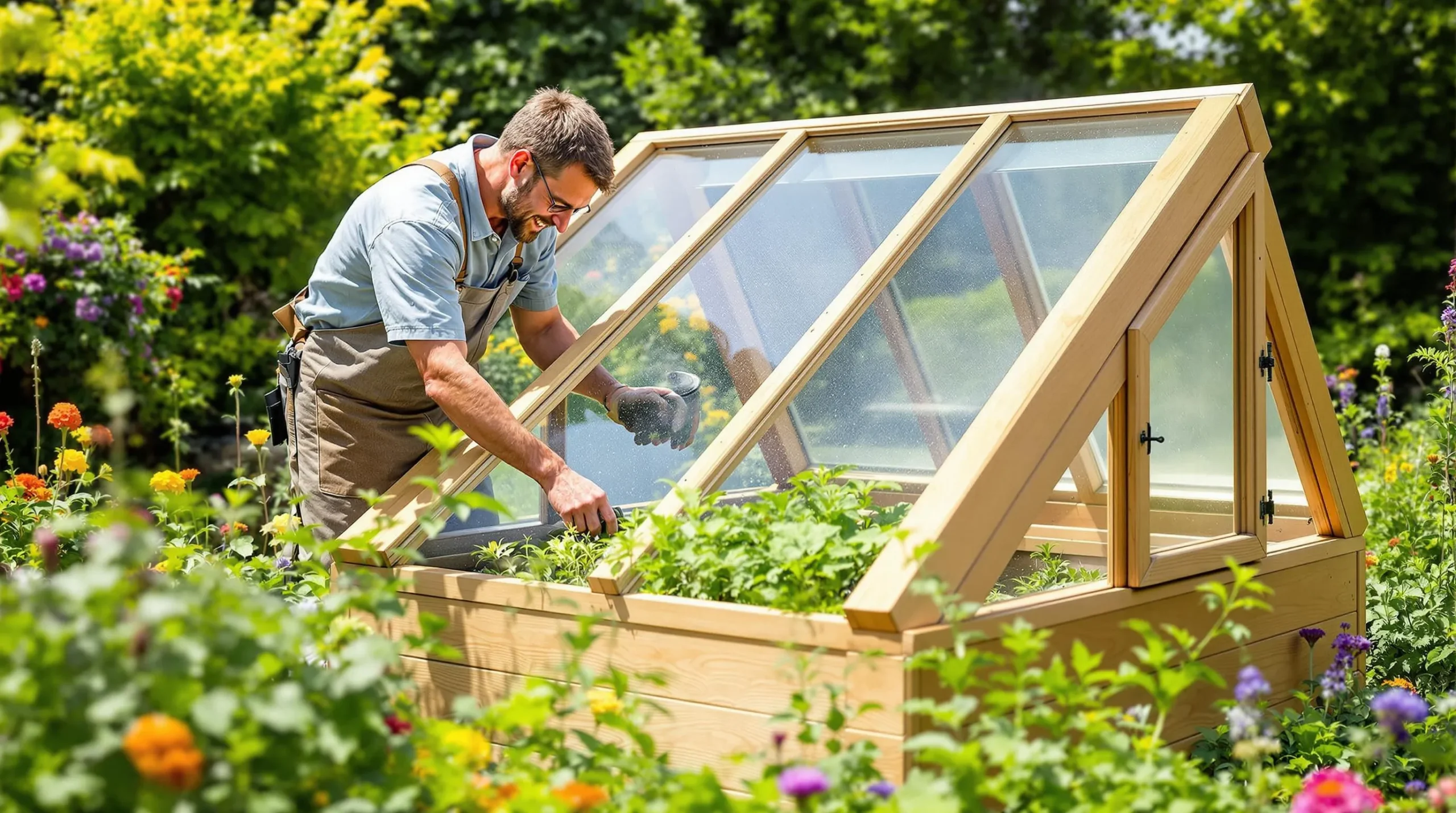
Learn how to make a cold frame to extend your growing season, protect plants in winter, and grow seedlings all year. Simple, cost-effective, and DIY-friendly!